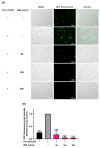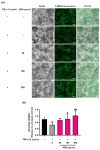Anoectochilus burmannicus Extract Rescues Aging-Related Phenotypes in Drosophila Susceptible to Oxidative Stress-Induced Senescence
- PMID: 40565158
- PMCID: PMC12192787
- DOI: 10.3390/ijms26125694
Anoectochilus burmannicus Extract Rescues Aging-Related Phenotypes in Drosophila Susceptible to Oxidative Stress-Induced Senescence
Abstract
Aging is a significant risk factor for various conditions, including neurodegeneration, cardiovascular disease, and type 2 diabetes. The accumulation of reactive oxygen species (ROS) and a decline in antioxidant defense are mechanisms that are widely acknowledged as causing the acceleration of both aging and the onset of age-related diseases. To promote longevity and reduce the risk of the development of aging-related disorders, it is essential to prevent or minimize oxidative stress and enhance antioxidant defense. It has been shown that Anoectochilus burmannicus (AB), a jewel orchid rich in phenolic compounds, can impact various biological activities associated with aging prevention. These activities include antioxidant, anti-inflammation, anti-insulin resistance, and anti-obesity effects. The aim of this study was to explore whether AB extract (ABE) could serve as an anti-aging agent using a Sod1-deficient Drosophila model, which accelerates the process of aging through ROS production. The results demonstrated that ABE, at a concentration of 2.5 mg/mL, significantly extended the lifespan of the flies and helped maintain their locomotor activity as they aged. ABE also reduced the age-related accumulation of damaged proteins in the muscle of the flies by inhibiting the expression of Gstd1, a genetic marker for oxidative stress. This finding agrees with those from in vitro experiments, which have shown the potential for ABE to reduce the production of ROS induced by H2O2 in myoblasts. ABE has been shown to attenuate insulin resistance, an age-related disorder, by inhibiting the pro-inflammatory cytokine TNF-α, which in turn increased insulin-stimulated glucose uptake in adipocytes. These findings suggest a promising role of ABE as an ingredient in functional foods or nutraceuticals aimed at promoting health, preventing oxidative stress, and potentially managing age-associated diseases.
Keywords: age-related disorder; functional food; locomotor activity; longevity promotion; medicinal plants; orchid; oxidative stress.
Conflict of interest statement
The authors declare no conflicts of interest.
Figures





Similar articles
-
Ferroptosis and Senescence: A Systematic Review.Int J Mol Sci. 2023 Feb 11;24(4):3658. doi: 10.3390/ijms24043658. Int J Mol Sci. 2023. PMID: 36835065 Free PMC article.
-
Systemic pharmacological treatments for chronic plaque psoriasis: a network meta-analysis.Cochrane Database Syst Rev. 2017 Dec 22;12(12):CD011535. doi: 10.1002/14651858.CD011535.pub2. Cochrane Database Syst Rev. 2017. Update in: Cochrane Database Syst Rev. 2020 Jan 9;1:CD011535. doi: 10.1002/14651858.CD011535.pub3. PMID: 29271481 Free PMC article. Updated.
-
Survivor, family and professional experiences of psychosocial interventions for sexual abuse and violence: a qualitative evidence synthesis.Cochrane Database Syst Rev. 2022 Oct 4;10(10):CD013648. doi: 10.1002/14651858.CD013648.pub2. Cochrane Database Syst Rev. 2022. PMID: 36194890 Free PMC article.
-
Systemic pharmacological treatments for chronic plaque psoriasis: a network meta-analysis.Cochrane Database Syst Rev. 2021 Apr 19;4(4):CD011535. doi: 10.1002/14651858.CD011535.pub4. Cochrane Database Syst Rev. 2021. Update in: Cochrane Database Syst Rev. 2022 May 23;5:CD011535. doi: 10.1002/14651858.CD011535.pub5. PMID: 33871055 Free PMC article. Updated.
-
Global consensus on optimal exercise recommendations for enhancing healthy longevity in older adults (ICFSR).J Nutr Health Aging. 2025 Jan;29(1):100401. doi: 10.1016/j.jnha.2024.100401. Epub 2025 Jan 1. J Nutr Health Aging. 2025. PMID: 39743381 Free PMC article. Review.
References
MeSH terms
Substances
Grants and funding
LinkOut - more resources
Full Text Sources
Medical
Miscellaneous

